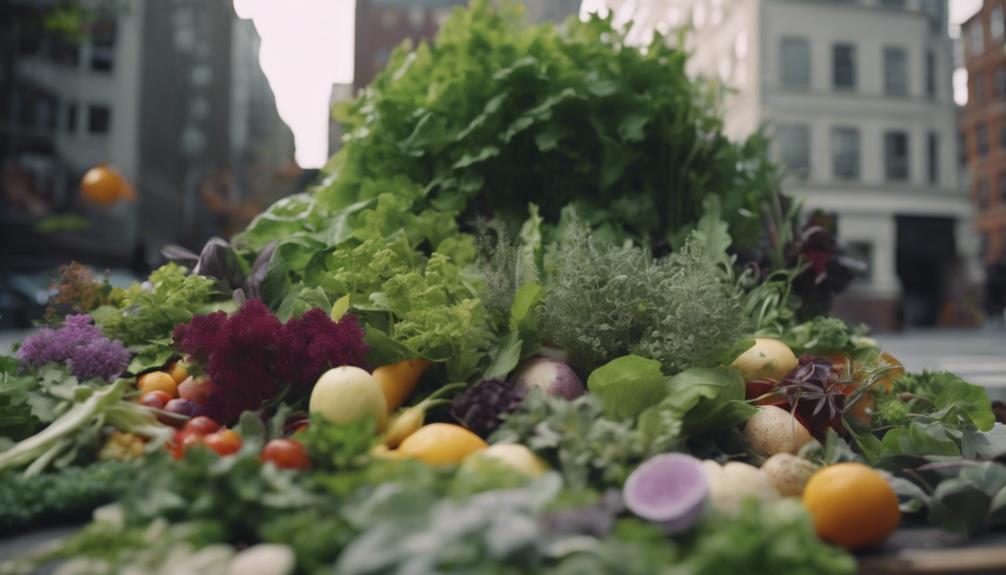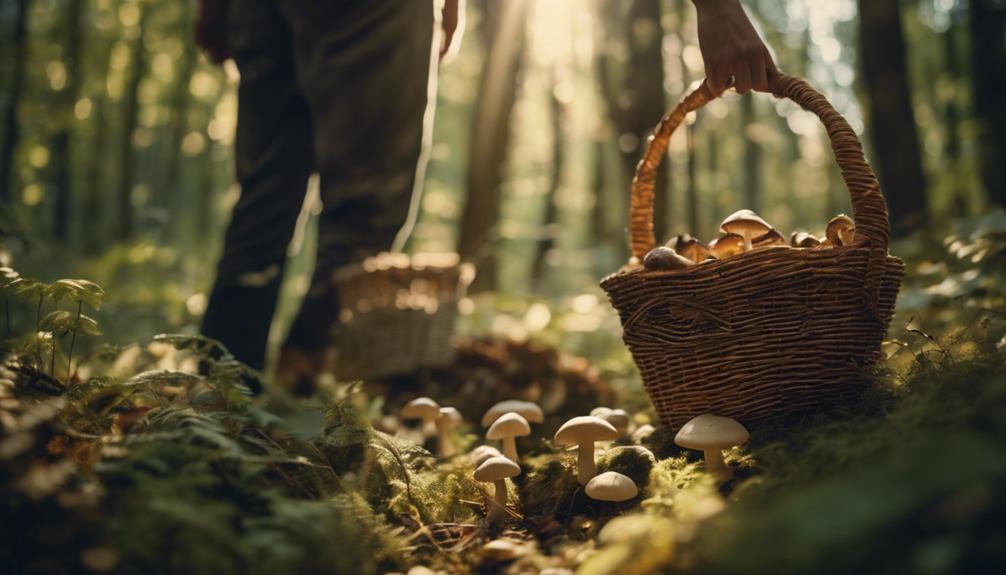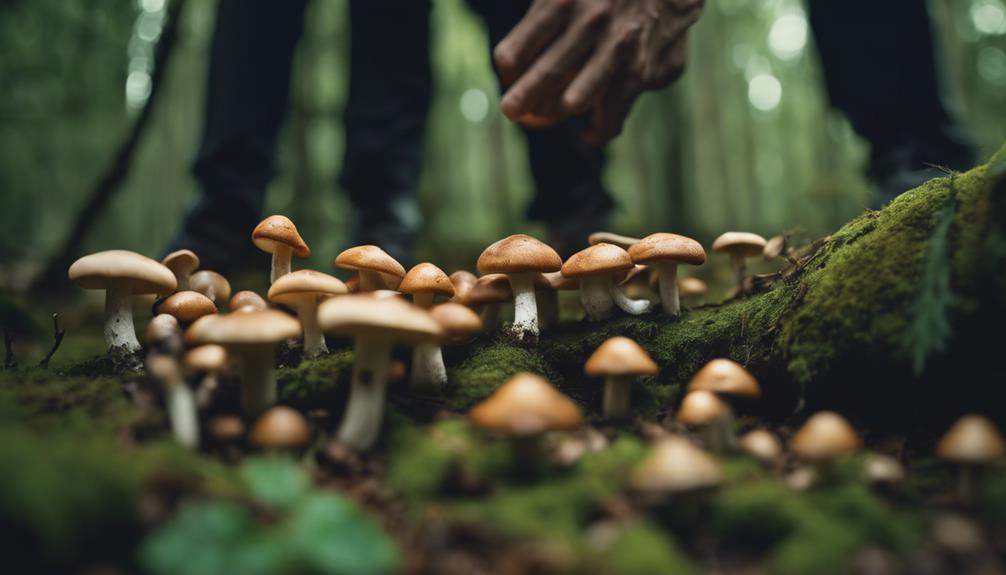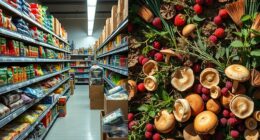Embark on an exciting journey of mushroom foraging. Remember to bring a breathable bag, a sharp knife, and a GPS. Wear tick-resistant clothing and carry an ID guide. Educate yourself on edible mushrooms and their characteristics. Get involved with mycological societies and identify different habitats. Stay safe by using proper gear and recognizing mushrooms. Take note of habitats, pay attention to unique characteristics, and use sensory clues for identification. Harvest by cutting close to the ground, handling gently, and leaving some behind. Cook your mushrooms by sautéing, grilling, or pickling them with complementary ingredients. Store them in paper bags, dehydrate, or pickle for long-lasting enjoyment. Follow storage tips to keep them fresh. Become a master of mushroom foraging; there’s so much more to explore.
Key Takeaways
- Pack essential gear for safety and identification.
- Learn mushroom identification techniques from experts.
- Harvest mushrooms carefully, leaving some for the ecosystem.
- Cook wild mushrooms using various methods and pairings.
- Preserve mushrooms by dehydrating or pickling for extended enjoyment.
Gear Up
When preparing to go mushroom foraging, make sure to gear up properly to guarantee a successful and safe experience. Mushroom foraging takes careful preparation, and having the right equipment is essential.
Pack a foraging bag with a permeable bottom to allow mushroom spores to disperse naturally as you move through the forest. This simple step not only helps with the ecosystem but also ensures a sustainable foraging practice.
Additionally, using a sharp knife for mushroom identification and gathering is important. Clean cuts are important to preserve the fungi and prevent contamination.
Carrying a GPS tracker can also be beneficial during your foraging expedition. This device allows you to mark productive spots where you find abundant mushrooms, making it easier to revisit these areas in the future.
In addition, wearing tick-proof clothing and using repellent is crucial to protect yourself from tick bites while exploring the wilderness. Always have a mushroom identification guide on hand to assist you in properly identifying the fungi you encounter.
Proper gear and preparation are key to a successful mushroom foraging adventure.
Learn Basics
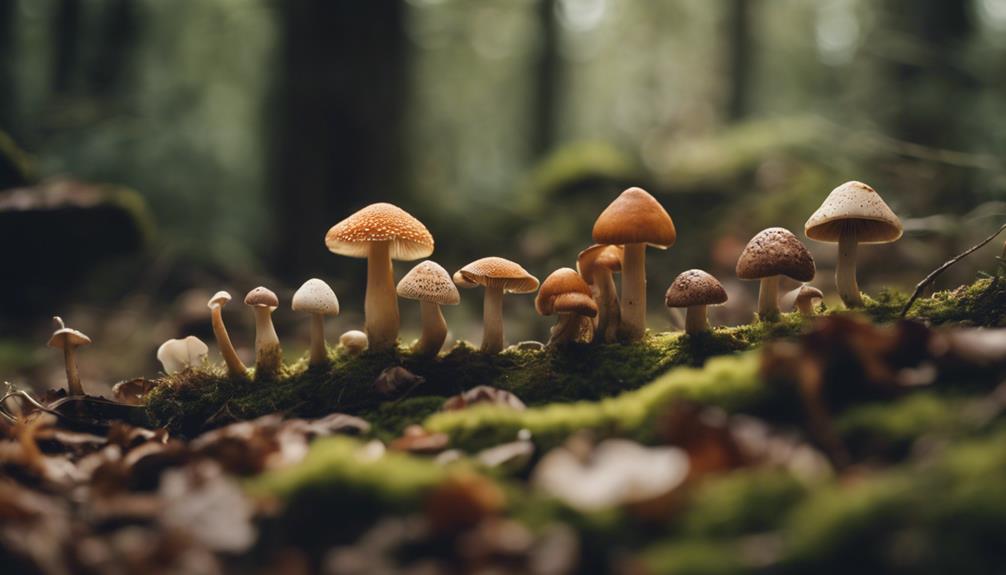
To begin your mushroom foraging journey, acquiring a solid understanding of the basics is paramount for your safety and success in the wild. Here are some essential steps to get you started:
- Identify Edible Mushrooms: Knowing how to distinguish between edible and toxic mushrooms is essential. Study the characteristics of common edible mushrooms in your area, such as the morel, chanterelle, or porcini. Understanding their features will help you make informed choices while foraging.
- Learn Mushroom Species: Familiarize yourself with different mushroom species and their unique traits. Each species has specific growth patterns, colors, shapes, and habitats. By recognizing these distinctions, you can narrow down your search and increase your chances of finding desirable mushrooms.
- Seek Expert Guidance: Joining local mycological societies, attending guided hikes, and participating in workshops can provide valuable insights from experienced foragers. These interactions can enhance your knowledge of wild fungi, improve your identification skills, and connect you with a community passionate about mushrooms.
Stay Safe

Safeguard your safety while mushroom foraging by following these essential guidelines. Always carry a sharp knife for mushroom identification and gathering to steer clear of toxic look-alikes that may be harmful if ingested.
When venturing into tick-prone areas, don tick-proof clothing and apply repellent. Make sure you have tick tweezers on hand for safe removal in case of any encounters.
Stick to easily recognizable mushrooms as a beginner to reduce the risk of accidentally consuming toxic species. Be cautious of foraging in polluted areas to prevent contamination of your wild food finds.
Identify Mushrooms
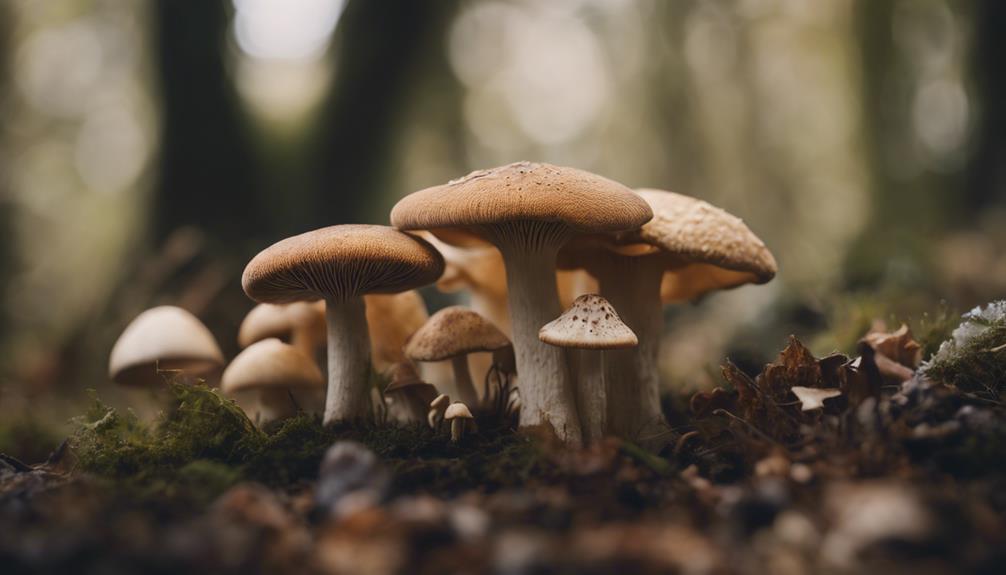
To accurately identify mushrooms, familiarize yourself with key characteristics like cap shape, gill color, and stem texture.
Be cautious of toxic look-alikes that may resemble edible species, and consult field guides to aid in your identification process.
Remember to pay attention to details like spore print color, presence of a veil or ring on the stem, and any distinctive odors or tastes to guarantee a safe foraging experience.
Mushroom Characteristics
When identifying mushrooms, pay close attention to key features such as gill attachment, color, cap shape, and spore print for accurate classification. To effectively distinguish between different mushroom species, consider the following:
- Habitat Observation: Note if the mushroom grows on wood, soil, or decaying matter, as this can provide essential clues for identification.
- Unique Characteristics: Look for special features like veils, rings, and volvas that are unique to certain mushroom species and aid in differentiation.
- Sensory Cues: Consider the scent, texture, and taste of the mushroom, as these sensory cues can be valuable indicators for identification purposes.
Additionally, utilizing a magnifying glass to examine fine details like spore size, shape, and ornamentation can further enhance the precision of your identification process.
Toxic Look-Alikes
Watch out for toxic mushroom look-alikes that closely resemble popular edible varieties, as mistaking them can have significant health consequences.
Some of these toxic look-alikes include the deadly Galerina marginata, which can be mistaken for Honey mushrooms, and the poisonous Cortinarius species, which bears a resemblance to Chanterelles. It's important to be able to differentiate between these species to avoid potential poisoning incidents.
For instance, the Destroying Angel (Amanita bisporigera) may look similar to the edible Puffball mushroom, but it's highly toxic, causing severe gastrointestinal distress and potentially fatal consequences if ingested. Similarly, the Deadly Webcap (Cortinarius rubellus) can be confused with Chanterelles, yet consuming it can result in organ failure and death.
Other dangerous look-alikes include False Morels (Gyromitra spp.), often mistaken for true Morels, and the Death Cap (Amanita phalloides), which resembles Paddy Straw mushrooms but is one of the most deadly fungi, causing liver and kidney failure if consumed.
Being able to accurately identify these toxic counterparts is paramount for safe mushroom foraging practices.
Field Guide Resources
Utilizing reliable field guides is essential for accurately identifying various mushroom species during foraging expeditions. When it comes to identifying mushrooms, field guides are your best friend. Here's why they're vital for your mushroom hunting adventures:
- Comprehensive Information:
Field guides provide detailed descriptions, color photographs, and identification keys that help you distinguish between different mushrooms and their look-alikes.
- Wide Coverage:
These guides cover a vast array of mushroom species, making it easier for you to accurately classify and identify fungi in their natural habitats.
- Safety and Learning:
Especially important for beginners, field guides not only aid in safe foraging practices but also serve as valuable tools to expand your knowledge about the diverse world of mushrooms.
Carrying a reliable field guide isn't just a recommendation; it's a necessity for anyone venturing into the world of mushroom foraging. Expert or novice, having this resource at your fingertips can make all the difference in your foraging experience.
Harvesting Techniques

To harvest mushrooms effectively, cut them close to the ground with a sharp knife to minimize damage to the mycelium. Foragers need to be careful not to disturb the intricate network that supports mushroom growth. Use a foraging bag with a permeable bottom to allow spores to disperse naturally as you collect mushrooms. Avoid pulling mushrooms out by the roots, as this can harm the mycelium and hinder future growth. Handle mushrooms gently to prevent bruising or damaging their delicate structures. Remember to leave some mushrooms behind to support the ecosystem and guarantee the sustainability of mushroom populations.
| Harvesting Techniques | Image |
|---|---|
| Cut mushrooms close to the ground |  |
| Use a foraging bag with a permeable bottom |  |
| Handle mushrooms gently |  |
Cooking Tips

As you shift from harvesting to cooking wild mushrooms, explore various techniques to enhance their flavors and textures. Here are some cooking tips to help you make the most of your wild mushroom finds:
- Sauté with Butter and Garlic: Elevate the flavor of wild mushrooms by sautéing them in butter along with garlic and herbs. This classic cooking method brings out the rich earthy tones of the fungi.
- Experiment with Different Cooking Methods: Try grilling, roasting, or pickling wild mushrooms to experience a range of textures and tastes. Each method can bring out unique flavors in the mushrooms.
- Incorporate into Various Dishes: Use wild mushrooms in risottos, pasta dishes, soups, and stews to add a savory umami boost to your meals. Pair them with ingredients like truffle oil, balsamic vinegar, or fresh herbs to enhance their taste further.
Preserve Your Finds

To preserve your foraged mushrooms effectively, start by storing them in a paper bag or basket with proper ventilation to prevent spoilage.
Consider dehydrating your mushrooms to prolong their shelf life, either using a dehydrator or air-drying methods.
Additionally, explore pickling as a method to infuse your mushrooms with unique flavors, ensuring they can be enjoyed for an extended period.
Proper Storage Techniques
For the best preservation of your foraged mushrooms, make sure to follow proper storage techniques to maintain their freshness and quality.
Here are some tips to help you properly store your wild fungi:
- Choose the Right Container: Opt for a paper bag or basket with good air circulation to prevent mold growth and maintain the mushrooms' texture.
- Avoid Plastic Bags: Steer clear of plastic bags as they can cause mushrooms to become slimy and deteriorate quickly due to trapped moisture.
- Use Refrigeration Wisely: Keep your mushrooms in the refrigerator's crisper drawer or on a tray lined with a damp paper towel to retain their freshness. Additionally, using a mesh bag or basket in the fridge can help extend their shelf life by allowing proper airflow.
Dehydration for Longevity
Considering the longevity of your foraged mushrooms, preserving them through dehydration is a highly effective method that retains their flavor and nutritional benefits. Dehydration removes moisture from the mushrooms, allowing them to be stored for extended periods without compromising their umami-rich taste. Here is a table summarizing the key points about dehydrating mushrooms:
| Dehydration for Longevity |
|---|
| Benefits |
| – Preserves flavor |
| – Retains nutritional value |
| – Extends shelf life |
| Methods |
| – Food dehydrator |
| – Oven drying |
| – Air-drying |
| Rehydration |
| – Soak in warm water or broth |
| – Use in soups, stews, or sauces |
When dehydrating mushrooms, make sure they are fully dried before storage to prevent mold growth. Rehydrate them by soaking in warm liquid for the best texture and taste. Dehydrated mushrooms are a versatile ingredient that can enhance the flavor of various dishes while providing a convenient long-term storage solution.
Pickling for Flavor
Preserving your foraged mushrooms through pickling can add a flavorful twist to your finds and extend their shelf life.
When pickling mushrooms, consider the following:
- Flavor Combinations: Experiment with different spices, herbs, and aromatics to create unique flavor profiles. Common ingredients like garlic, thyme, peppercorns, or red pepper flakes can enhance the taste of your pickled mushrooms.
- Brine Preparation: Vinegar, salt, and sugar are essential components of the brine used for pickling mushrooms. Balancing these ingredients correctly is vital for achieving a delicious final product.
- Versatile Usage: Pickled mushrooms can be enjoyed in various ways. Add them to salads for a tangy kick, include them in sandwiches for added depth of flavor, or use them to elevate your charcuterie boards.
Frequently Asked Questions
How Do You Hunt for Fungi?
To hunt for fungi, explore moist areas near trees and fallen logs. Look after rain or in warm weather. Use a sharp knife and foraging bag for collection. Remember safety guidelines while identifying mushrooms.
What Is the Trick to Finding the Mushroom?
To uncover nature's hidden gems, seek the subtle whispers of mycelium underfoot. Follow the dance of rain and sun, for mushrooms emerge like secrets whispered by the earth. Let the woods reveal their treasures to you.
What Are the Rules for Mushroom Foraging?
When mushroom foraging, remember to always respect property rights, check local regulations, leave no trace, harvest responsibly, and follow ethical guidelines. By doing so, you can enjoy the hunt while preserving nature's balance.
What Time of Year Is Best for Mushroom Hunting?
In your quest for wild fungi treasures, the lush bounty of late summer to fall reveals the prime time for mushroom hunting. Embrace the cooler days and dampness of autumn for your mushroom foraging adventures.
Conclusion
Now that you've mastered the art of mushroom foraging, the forest is your oyster! Remember, the world of wild fungi is vast and diverse, so always be cautious and continue learning.
With the right gear, knowledge, and safety precautions, you'll be on your way to becoming a fungi expert in no time.
Happy hunting, and may your baskets overflow with the most delectable mushrooms imaginable!


